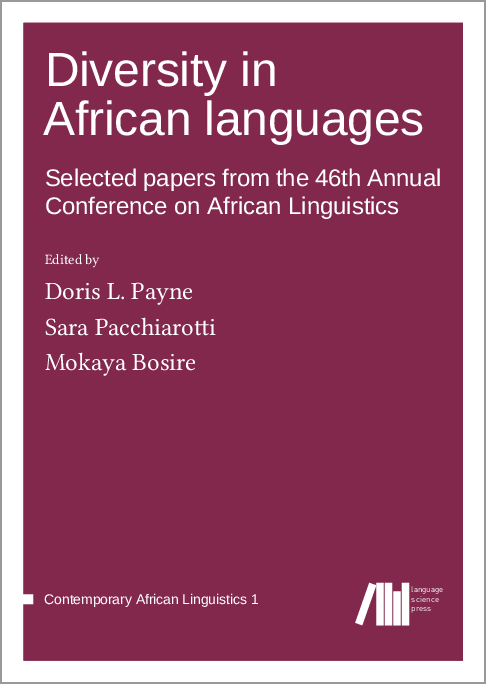We log anonymous usage statistics. Please read the privacy information for details.
Diversity in African languages: Selected papers from the 46th Annual Conference on African Linguistics
Synopsis
Diversity in African Languages contains a selection of revised papers from the 46th Annual Conference on African Linguistics, held at the University of Oregon. Most chapters focus on single languages, addressing diverse aspects of their phonology, morphology, semantics, syntax, information structure, or historical development. These chapters represent nine different genera: Mande, Gur, Kwa, Edoid, Bantu, Nilotic, Gumuzic, Cushitic, and Omotic. Other chapters investigate a mix of languages and families, moving from typological issues to sociolinguistic and inter-ethnic factors that affect language and accent switching. Some chapters are primarily descriptive, while others push forward the theoretical understanding of tone, semantic problems, discourse related structures, and other linguistic systems. The papers on Bantu languages reflect something of the internal richness and continued fascination of the family for linguists, as well as maturation of research on the family. The distribution of other papers highlights the need for intensified research into all the language families of Africa, including basic documentation, in order to comprehend linguistic diversities and convergences across the continent. In this regard, the chapter on Daats’íin (Gumuzic) stands out as the first-ever published article on this hitherto unknown and endangered language found in the Ethiopian-Sudanese border lands.
Chapters
-
Tone features revisitedEvidence from Seenku
-
Intonation and emotions in KɔnniA preliminary study
-
The coding of identifiability in Mooré
-
The syntactic status of objects in Mooré ditransitive constructions
-
All-in-one and one-for-allThetic structures in Buli grammar and discourse
-
Beyond resumptives and expletives in Akan
-
Valency changing processes in Akan
-
Degema clitics and serial verb constructions at the syntax/phonology interface
-
Coronal palatalization in Logoori
-
Remote past and phonological processes in Kaonde
-
The future in Logoori oral texts
-
Quantification in Logoori
-
The syntactic structure of negation in Ndebele
-
The productivity of the reversive extension in Standard Swahili
-
The anticausative alternation in Luragooli
-
The locative applicative and the semantics of verb class in Kinyarwanda
-
The Ndebele applicative construction
-
Differential object marking in Mozambican languages
-
The interaction of two focus marking strategies in Luganda
-
Variation in the expression of information structure in eastern Bantu languages
-
Number marking in Lopit, an Eastern Nilotic language
-
Daatsʼíin, a newly identified undocumented language of western EthiopiaA preliminary examination
-
Somali gender polarity revisited
-
The development of finite verbs from nominalized structures in Northern Mao
-
Niger-Congo transitive reciprocal constructions and polysemy with reflexives
-
STAMP morphs in the Macro-Sudan Belt
-
Igbo-English intrasentential codeswitching and the Matrix Language Frame model
-
Humor in Kenyan comedy




